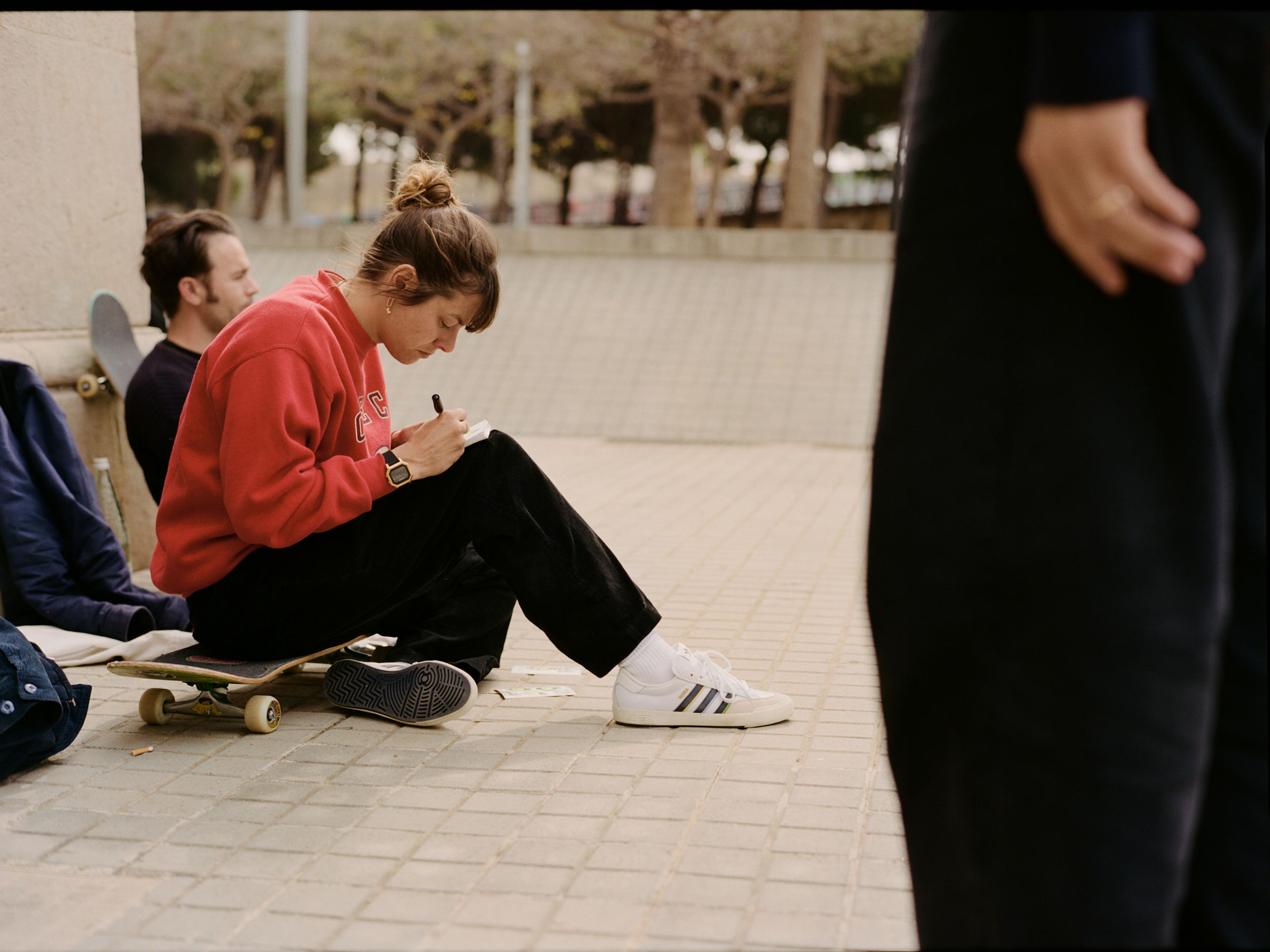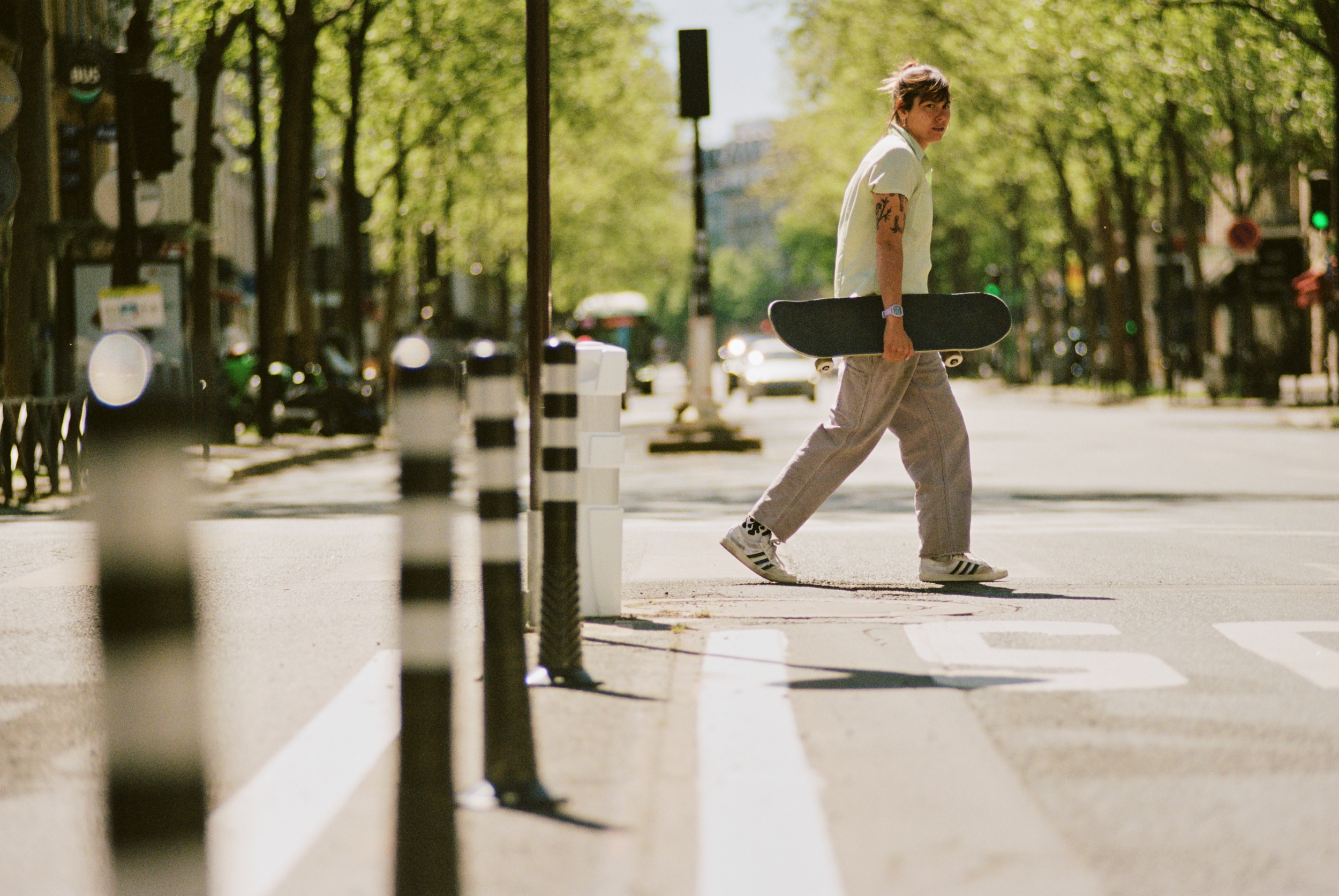The athlete and artist joins Document to reflect on the sport as a mode of healing, and how to foster a more inclusive community
Nora Vasconcellos is the image of neoteric skateboarding. As the first female rider for adidas, she is breaking ground for future generations of skateboarders, and others establishing themselves in male-dominated fields. Driven by passion in its truest state, Nora made skating a priority from a young age, and after four and a half years solidifying herself as part of Welcome Skateboards, adidas Skateboarding approached her. “I hope I can be a positive force and someone that young people can see a bit of themselves in,” she muses. “I think, right now, the inclusion and overall participation of girls in skateboarding is incredible. It’s been a long time coming.”
The athlete and artist isn’t content in acting as an untouchable point of inspiration alone, Vasconcellos has also extended her voice as an advocate for mental health awareness. Having grown up with a panic disorder, she utilized skateboarding as a way to extend the limits of her comfort, and face her anxiety head-on.
The skater finds inspiration from “everywhere.” Sometimes it’s her cat, or the music she’s listening to. “I hope to help [encourage] people to be true to themselves, and leave their communities better for it.” Vasconcellos joins Document to examine the influence of skateboarding on her healing, the ideation of her recent footwear and apparel line NORA, and the ways in which her art practice informs her day-to-day life.
Syd Walker: Can you tell me about what it was like being raised in Massachusetts, and why you eventually decided to move to California?
Nora Vasconcellos: Massachusetts was a really nice place to grow up; we had the woods and the beach. It was really wonderful for everything, except surfing and skateboarding, which was why I moved to California in 2012. I wanted to immerse myself in that, and be around like-minded people who were as passionate as I was about skating. The weather was also a big factor.
Syd: Do you feel like California is home now?
Nora: I do, to an extent. I think Massachusetts is always going to be my home, but I am set on putting down roots here. Living in California—especially North County San Diego, the last six years—has really helped me establish myself. When I first moved here, I was living in Orange County. I got a job at Welcome Skateboards, [where] I worked full-time for four and a half years, until I was sponsored by adidas and could focus on skateboarding. Welcome is like family to me, and the opportunity to learn about the industry from the inside out made it possible for me to turn pro and do things the way I wanted to.
Syd: Can you pinpoint a specific moment when you realized I’m going to skate forever, or have you always felt that skating was part of your DNA?
Nora: It was just always something I knew that I wanted to do. When I graduated high school and had to make financial decisions, I decided I wanted to put all of my effort into living in California and pursuing skating. To not skate was never an option.
Syd: Who are your favorite people to skate with?
Nora: Just my friends—Nicole Hause, Jimmy Wilkins, Kev White, Jack Fardell, Marbie Miller—the whole Adidas skateboarding crew. Anyone who knows how to have fun.
Syd: How do your friends influence your approach to skating?
Nora: I think the overall energy of a session or trip can dictate everything. I like it when I can skate with my friends and have a good laugh. It’s also helpful to have friends around when you are battling a trick; they can help motivate you and keep you level-headed, and are there to celebrate with you when you land it.
Syd: What’s your favorite and least favorite element of filming a video part?
Nora: My favorite thing is overcoming a trick battle and landing something I didn’t think I was capable of.
Surprising yourself and persevering [can also be] the worst part mentally, when you feel like you’re going to lose your mind. Sometimes I get too in my head and feel like I’m just [stuck] on repeat—not landing a trick for hours or days. It sucks more than anything to walk away without a trick. Or, when you get hurt and physically have to stop.
Syd: What part does your art practice play in your day-to-day life? Does it intertwine with your skate career, or is it a separate outlet?
Nora: Art is certainly a part of my day-to-day life. My dad is an illustrator, so I was always around art—it goes hand in hand with skateboarding. I love that creating art gives me the same flow state without going as hard on my body as I do when skateboarding. Sitting and getting lost in sketching or painting is so fun.
Syd: Do you have a dream illustration project?
Nora: I’d love to illustrate a children’s book. It seems like such a massive endeavor, but I know if I put my mind to it, I’d love the process.
Syd: And what were you hoping to do in creating your clothing line, NORA?
Nora: The goal was to pull from classic tennis apparel to complement the shoe. The tracksuit was an obvious choice, and the knit polo tied it to my personal style. Making the range genderless with adidas UNITEFIT was a priority, along with [establishing] the sustainability of the collection.
Syd: What’s your holy grail piece from this collection?
Nora: That would definitely be the knit polo. The pattern is my original artwork in a jacquard knit, which is so cool. I think there’s so much potential to combine art in knitwear. Also, the timelessness of the polo is really cool.
Syd: I’m sorry to hear about your recent injury. What’s it been like to slow down and focus on the healing process?
Nora: It comes with the territory. I’ve been fortunate that in 18 years of skateboarding, this is my first major injury. I’m learning a lot, especially how to let my friends and family take care of me, how to slow down and rest. I’m thankful that by December, I’ll be mobile again, and back into physical therapy and the ocean.
Syd: You’ve spoken a bit on living with panic disorder. How has that impacted your career?
Nora: Wanting to travel while being a skateboarder has really forced me out of my comfort zone and into the process of healing. It has taken many, many years of therapy and suffering in silence to become accepting of myself, which, ultimately, has given me less anxiety.
Syd: Have you always been open about your journey with mental health, or was there a time when it felt uncomfortable to speak about?
Nora: No, and I think that is why I was so tormented and stuck. I was 23 when I faced it head on, and at that point, I had suffered with it for almost ten years. I missed out on so much stuff as a teenager because of my panic and anxiety. I’m just happy that I was able to get out of that cycle and start living my life.
Syd: You’re now seen as a role model for girls in skateboarding, and for young people breaking into male-dominated spaces. Have you witnessed shifts in your communities that make you excited or hopeful for the generations to come?
Nora: I hope I can be a positive force and someone that young people can see a bit of themselves in. I think, right now, the inclusion and overall participation of girls in skateboarding is incredible. It’s been a long time coming.
Syd: Is there a brand, crew, or individual you can reference that is a stand out in also contributing to the evolution of inclusion in the skate industry?
Nora: So many. With skateboarding specifically, I think about Mimi Knoop, Carabeth Burnside, Alexis Sablone, and Elissa Steamer. They paved roads for women like myself, and have always been great friends to me.
Seeing Nicole Hause and Samaria Brevard ruling right now is incredible. The young girls are all on some other shit. They are cool, smart, stylish—they support each other and are so aware of the world. It’s just incredible.
Syd: Are there any moments of your career that stand out as most memorable?
Nora: Just every minute that I get to do what I love. Even now, in bed with a broken leg and the cat laying on my foot, it’s all part of the journey.
Syd: What legacy do you want to leave?
Nora: I hope to help people be true to themselves, and leave their communities better for it.















